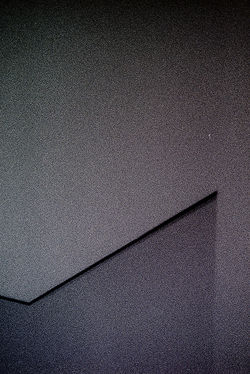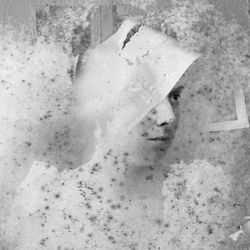
Monochrome
A curated international photography exhibition
June 3 – 26, 2021 newsletter
 |  |
|---|---|
 |  |
 |  |
 |  |
 |  |
 |  |
 |  |
 |  |
 |  |
 |  |
 |  |
 |  |
 |  |
 |  |
 |  |
 |  |
 |  |
 |  |
 |  |
 |  |
 |  |
 |  |
 |  |
 |  |
 |  |
 |  |
 |  |
 |  |
 |  |
 |  |
 |  |
 |  |
 |  |
 |  |
 |  |
 |  |
 |  |
 |
Click on the thumbnail to view the image. Click on the image for a larger view and information.
Monochrome photography is usually associated with black and white images. However, in the history of photography other hues, such as sepia and cyan were also used, and today there are countless examples of monochromatic images whose photographic qualities are based on the tonal range of various other colours. While monochromacity used to be a technological limitation for a long time, today it is more of an artistic choice. Photographers may opt for working with the shades of just one colour for compositional reasons or for reasons related to the expressive content of their images, and therefore their decision is to be interpreted. Our appreciation of contemporary monochromatic images is also rooted in the knowledge that the lack of colour range is significant and meaningful, not merely a technological limitation.
Curator's choice
Charles Crain: Salt River Pima Tribe - Sampling at Market
Honourable mentions
Thierry Camus: Half-open
Dorie Dahlberg: Defying The Weather Report
Simone Madeo: Intersection
Exhibiting photographers
Debra Achen (Monterey, CA, USA), Mildred Alpern (New York, NY, USA), Jeremy Bach (Canandaigua, NY, USA), Emmanuelle Becker (Paris, France), L. J. Blanksma (Hoquiam, WA, USA), Marco Bordignon (Accra, Ghana), Bill Bowerman (Lawrence, KS, USA), Derek Brown (Bangkok, Thailand), Thierry Camus (Paris, France), Brian Cann (Waldenbuch, Germany), Fred Carter (Fremont, CA, USA), Jeroen Cavents (Leipzig, Germany), Ilinca Ciubotariu (New York, NY, USA), Charles Crain (Miami, FL, USA), Mingyi Cui (London, UK), Michela D'Onofrio (Geneva, Switzerland), Dorie Dahlberg (Long Branch, NJ, USA), Paul Delpani (Vienna, Austria), Peter Devenyi (Ottawa, Canada), Todd Dieringer (Akron, OH, USA), Laurie Toby Edison (San Francisco, CA, USA), Stephanie Fodrey (Denver, CO, USA), Barbara Frye (Jona, Switzerland), László Gálos (Salgótarján, Hungary), Cristian Geelen (Haarlem, Netherlands), Simon Gellért (Csanádpalota, Hungary), Nadide Goksun (WhitePlains, NY, USA), Suzanne Gonsalez-Smith (Grand Forks, ND, USA), Megan Hatch (Portland, OR, USA), Robert S Johnson (New York, NY, USA), Giedrius Jokubauskis (Berlin, Germany), Emilia Kashfian (Los Angeles, CA, USA), Aashish Kaul (Albany, NY, USA), Elizabeth Kayl (Loveland, CO, USA), Phanuphan Kitsawaeng (Bangkok, Thailand), John Kosmer (Fly Creek, NY, USA), Inbal Kristin (Ashkelon, Israel), Shifra Levyathan (Ramat-Gan, Israel), Richard Luxton (Bristol, UK), Simone Madeo (Alessandria, Italy), Laura Malaterra (Genova, Italy), Jane Ross (London, UK), Joseph Rovegno (New York, NY, USA), Marian Rubin (Montclair, NJ, USA), Carmen Schaefer (Rochester, NY, USA), Szilárd Schlauszky (Székesfehérvár, Hungary), Tina Sejbjerg (Amsterdam, Netherlands), Paul David Shea (Plymouth MA, USA), Stuart Skalka (Sparks, NV, USA), Allan Syphers (Gwynedd Valley, PA, USA), Judit Erzsébet Szabó (Budapest, Hungary), Carol Colby Tanenbaum (New York, NY, USA), Joshua Tann (Long Beach, CA, USA), Gökhan Tanrıöver (Madrid, Spain), Tomo Tany (Tokyo, Japan), Ilya Trofimenko (Dresden, Germany), Eiji Yamamoto (Saarbruecken, Germany), Root Yarden (Beit Hillel, Israel), Zheng Zhao (Beijing, China)
Please click on the names to see contact information (website or e-mail) where available.
Monochrome
Borbála Jász
We associate monochrome primarily with black-and-white photography. But in fact, the prominent and highlighted use of a single colour also results in a monochrome image. In the history of photography, in addition to black and white, cyan and sepia were also most popular, with a strong technical dependence. With the advent of colour photography, monochrome is more of an artistic choice than a technical image-making method. Limiting the colours used focuses our attention on the composition and the content being conveyed. Monochromaticity can appear in any photographic genre, relying on the trinity of texture, facture, and structure (László Moholy-Nagy) or to emphasise the content with its chromatic simplicity and clarity.
The curator’s choice is Salt River Pima Tribe - Sampling at Market by Charles Crain. The image is a portrait of a man with a toothpick. It is a well-captured moment in an ordinary situation, and as such it belongs to the genre of street photography. We see the characteristic features of the central character, the wrinkles of his face, and so we can draw conclusions about the man’s origins and life stories. The depicted person has very strong facial features, so the black-and-white composition gives the viewer only a partial freedom in reconstructing the image’s meaning. The photograph presents several contrasts: the smoothness of the hand and the roughness of the face; the pattern of the clothing is vertical and the pattern of the hair is horizontal; the sharp shape of the central figure contrasts with the blurring of the background.
One of the honourable mentions was the picture by Thierry Camus entitled Half-open. The photographer creates a static image but a dynamic composition with an exciting crop of the image and a smooth play of light and shadow. The multidimensional raster grid outlines many levels of diagonality that create diverse spatial dimensions. Thus, like the genre of op-art, it incorporates geometric principles into the composition. Defying the Weather Report by Dorie Dahlberg relates to the classical Baroque compositional heritage in painting. The plot placed in the landscape is open in space, time, and composition. The figures in the foreground are very contoured; in contrast, both the middle space and the background are blurred and faint. The bird in the upper right corner is what pulls the viewer back down to the ground after the feeling of floating outside of time and space. The third honourable mention is Simone Madeo’s Intersection. This is a classic still life with pears. The direction in which the pears are placed is the same as the positioning of the drapery, so that the composition, despite being open, still contracts rather than spreads apart. The texture of the fruits and drapery, as well as the light-shadow effect, results in an unusually strong image depth. The photograph is composed with elaborate proportions.
Monochromaticity can appear as a technical or compositional property, regardless of the photographic genre. In the case of landscapes, we encounter black-and-white compositions, or neutral-coloured and colourless landscapes. The first category includes photographs by Debra Achen, Dorie Dahlberg, Todd Dieringer, Megan Hatch, Aashish Kaul, Tomo Tany and Eiji Yamamoto. We need to distinguish neutral-coloured and colourless photographs (Mildred Alpern and Ilinca Clubotariu) from the application of a special colour (Marco Bordignon, Fred Carter, Barbara Frye, Laura Malaterra and Zheng Zhao). In the case of architectural compositions, be it interior or urban design, or geometric abstract constructions, the artists prefer to use monochrome (Emanualle Becker, Bill Bowerman, Thierry Camus, Jeroen Cavents, Simon Gellért, Suzanne Gonsalez-Smith, Emilia Kashflan, Judit Erzsébet Szabó and Ilya Trofimenko). The portraits in the exhibition show not only black and white, but also green, red, or even pink variations (Peter Devenyi and Robert S. Johnson). Due to the technological development of digital photography, the exhibition contains a very wide range of mixed media compositions too, exemplified by the photographs of Debra Achen, Gierdius Jakobauskis, Elisabeth Kayl, Inbal Kristin, Shifra Levyathan, Richard Luxton, Jane Ross, and Joseph Rovegno.